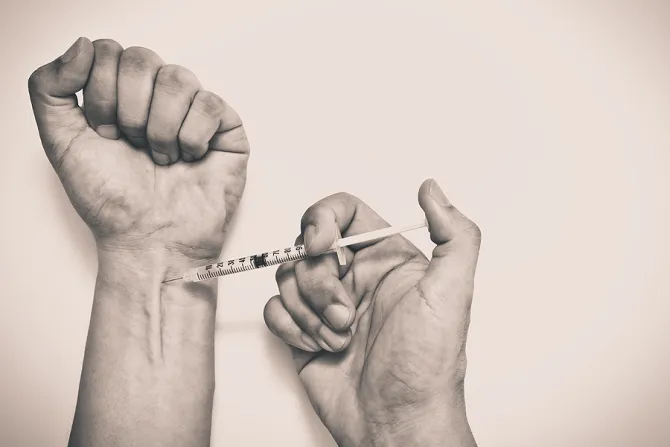Within three months, Chou was stealing from her roommate's stash of painkillers.
"The moment I found my drug of choice I felt instant relief. I was no longer terrified all the time and didn't worry about what people thought of me.
"I checked out: No problems were running through my head."
The drug use continued after Chou started her accounting job, and, over time, she headed on a downward spiral, as she began experimenting with other drugs. Visits to emergency rooms, stints in drug-rehabilitation programs, job loss, suicide attempts and homelessness followed.
The lowest point came when the young woman found herself "sitting outside of the police department, hoping God would have someone arrest me.
"I realized this would be the rest of my life - burning bridges every day and starting over the following day."
Her prayer was answered: Chou was arrested and eventually served time in Marin County Jail north of San Francisco.
In 2014, she got her life back on track after she was released from Marin County Jail and was accepted to Catherine Center, a restorative-justice program for women like her who have served time for drug convictions and related offenses. Sponsored by St. Vincent de Paul Society of San Mateo, Calif., in alliance with the Sisters of Mercy West Midwest, Catherine Center takes no government funds so it can provide a comprehensive faith-based program for women who face daunting challenges as they prepare to re-enter society and commit to staying clean and sober.
Over the past year and a half, Chou has participated in a 12-step program, made restitution, received counseling and taken part in structured spiritual reflection and prayer. More recently, she has mentored new arrivals to the program, as she holds a job and hones the skills she will need this fall, when she begins a program to earn a master's degree in business administration. But she believes the spiritual transformation she has undergone at Catherine Center, where she learned to hand over to God all the anxieties that have shadowed her life, is equally important.
People dealing with addiction need "constant help and accompaniment to help them remember that God loves them. They will encounter suffering, but they don't walk alone," Lorraine Moriarty, the executive director of St. Vincent de Paul Society of San Mateo, told the Register.
Other Factors
As Moriarty sees it, the recent epidemic of drug addiction can only be partly explained by the overuse of addictive painkillers. Other factors include a plague of loneliness and social isolation and the furious "pace" of modern life that fosters deep anxiety and leads some to treat emotional wounds with drugs.
Sociologists who have researched the broader social context of the nation's new drug crisis confirm Moriarty's judgment.
"Stressors such as poverty, divorce and economic insecurity are playing a role in people's response" to the seductive appeal of drug use, Mark Hayward, a professor of sociology at the University of Texas at Austin, told the Register.
As economic changes erode manufacturing jobs that once supported an entire family, the sharp rise in mortality rates for whites underscore the fact that in recent years "this group has lost more than other groups in society," said Haywood, yet their struggles have received little attention.
Whites who do not finish high school are much more likely to die from a drug overdose than college graduates, according to data published in this month's New York Times story. But this same demographic, the influential sociologist and best-selling author Charles Murray has pointed out earlier, is also less likely to marry, attend church or take part in other forms of civic engagement, and that leaves them more vulnerable to the ravages of drug addiction.
"The breakdown of the family and declining rates of marriage today disproportionately impacts lower-income individuals and those with less education," agreed Dr. Aaron Kheriaty, a psychiatrist at the University of California-Irvine Medical Center, who noted the intertwined rise in drug overdoses and suicides.
Kheriaty is a Catholic and has worked closely with the Diocese of Orange on mental-health initiatives. So when asked for suggestions on how local parishes should respond to the crisis, he pointed to "the corporal and spiritual works of mercy that have always had a central place in Catholic life."
A Catholic Response
Back in Providence, Deacon Flanigan identifies another factor that breeds drug dependency in 21st-century America: a culture of consumerism that encourages people to believe they have a right to "feel good."
"There is an existential crisis in our culture: We see this more clearly among our youth, but it affects all ages. I am speaking as a doctor and a deacon," he said.
"Society is so good at promoting consumerism, and we are told, 'Do what makes you feel good.' And it really does feel good to go shopping and get a hotshot car and have a really great alcoholic drink."
Yet the "false promise" of consumerism, he noted, leads people away from the path of a challenging, but ultimately fulfilling, life rooted in self-sacrifice for the sake of loved ones and to sustain the common good.
His words echo Pope Francis' critique of the West's "throwaway culture" and his call for the Church to be a "field hospital" for sinners.
Thus, while experts seek further restrictions on the use of drugs like OxyContin, and Catholic agencies work to expand access to treatment programs, Flanigan also wants to see more parishes acknowledge the reality of drug abuse and offer 12-step programs for Catholics and others in the community.
If the Church admits there is a problem, he suggested, it will encourage individuals and families who often struggle alone, too filled with shame to ask for help.
"The clientele for your 12-step meeting may not be the same as the clientele for your parish finance committee - though there may be overlap, and you don't know it," he said.
"We need to address the reality of drug addiction and tell those who are dealing with it that we are there to help them get the help they need."




